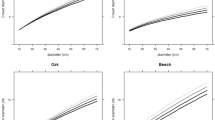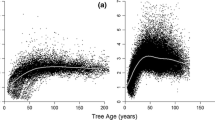Abstract
Intraspecific and interspecific architectural patterns were studied for eight tree species of a Bornean rain forest. Trees 5–19 m tall in two 4-ha permanent sample plots in primary forest were selected, and three light descriptors and seven architectural traits for each tree were measured. Two general predictions were made: (1) Slow growing individuals (or short ones) encounter lower light, and have flatter crowns, fewer leaf layers, and thinner stems, than do fast growing individuals (or tall ones). (2) Species with higher shade-tolerance receive less light and have flatter crowns, fewer leaf layers, and thinner stems, than do species with lower shade-tolerance. Shade-tolerance is assumed to decrease with maximum growth rate, mortality rate, and adult stature of a species.
Two light descriptors (crown position index and available space, but not canopy height) indicated higher light conditions for trees with more rapid growth, and for trees of greater height. Light levels were higher for species with high maximum growth rates and with greater adult stature.
Most intraspecific architectural patterns conformed to the predictions: total leaf area and the number of leaf layers increased with increasing height and higher growth rates, and crown length/tree height ratio and stem slenderness respectively increased and decreased with growth rate. Yet, crown width/tree height ratio and relative crown length did not change with tree height, nor did they with previous growth. Slow growing (and short) trees may not have the reserves to invest in further horizontal crown growth, and to avoid leaf self-shading sufficiently within their relatively narrow crowns.
Predictions on interspecific architectural patterns were not supported by the data. Species that were expected to be more shade-tolerant (lower maximum growth, lower mortality, and shorter stature) had deeper crowns, greater leaf areas, and more leaf layers, than did less shade-tolerant species. These patterns may be explained by lower loss rates of branches and leaves of the more shade-tolerant species. These species avoid leaf self-shading by distributing their leaves at the crown periphery. The role of lateral light appears to be more important than hitherto realized. The crown width/height ratio and height/dbh ratio were negatively correlated, both intraspecifically and interspecifically. It is suggested that trees co-ordinate their crown and stem growth so that they maintain their stability at small safety margins in the forest understorey.
Similar content being viewed by others
References
Ackerly, D. D. 1996. Canopy structure and dynamics: integration of growth processes in tropical pioneer trees. Pp. 619–658. In: Mulkey, S. S. Chazdon, R. L. & Smith, A. P. (eds), Tropical forest plant ecophysiology. Chapman & Hall, London.
Ackerly, D. D. & Bazzaz, F. A. 1995. Seedling crown orientation and interception of diffuse radiation in tropical forest gaps. Ecology 76: 1134–1146.
Aiba, S. & Kohyama, T. 1997. Crown architecture and life-history traits of 14 tree species in a warm-temperate rain forest: signifi-cance of spatial heterogeneity. J. Ecol. 85: 611–624.
Alvarez-Buylla, E. R. & Martinez-Ramos, M. 1992. Demography and allometry of Cecropia obtusifolia, a Neotropical pioneer tree-an evaluation of the climax-pioneer paradigm for tropical rain forests. J. Ecol. 80: 275–290.
Ashton, P. S. 1978. Crown characteristics of tropical trees. Pp. 591–615. In: Tomlinson, P. B. & Zimmermann, M. H. (eds), Tropical trees as living systems. Cambridge University Press, Cambridge.
Bongers, F. & Sterck, F. J. 1998. The architecture of tropical rain forest trees: responses to light. Pp. 125–162. In: Newbery, D. M. Prins, H. H. T. & Brown, N. (eds), Dynamics of tropical communities. Blackwell Science, Oxford.
Campbell, E. J. F. & Newbery, D. M. 1993. Ecological relationships between lianas and trees in lowland rain forest in Sabah, East Malaysia. J. Trop. Ecol. 9: 469–490.
Cannell, M. G. R. & Dewar, R. C. 1994. Carbon allocation in trees: a review of concepts for modelling. Adv. Ecol. Res. 25: 59–104.
Chazdon, R. L. 1986. The costs of leaf support in understorey palms: economy versus safety. Am. Nat. 82: 9–30.
Chazdon, R. L & Fetcher, N. 1984. Light environments of tropical forests. Pp. 27–36. In: Medina, E. Mooney, H. A. & Vasquez-Yanes, C. (eds), Physiological ecology of plants of the wet tropics. W. Junk, The Hague.
Clark, D. A. & Clark, D. B. 1992. Life-history diversity of canopy and emergent trees in a Neotropical rain forest. Ecol. Monogr. 62: 315–344.
Clark, D. B., Clark, D. A. & Rich, P. M. 1993. Comparative analysis of microhabitat utilization by saplings of nine tree species in Neotropical rain forest. Biotropica 25: 397–407.
Claussen, J. W. & Maycock, C. R. 1995. Stem allometry in a North Queensland tropical rain forest. Biotropica 4: 421–426.
Coleman, J. S., McConnaughay, K. D. M. & Ackerly, D. D. 1994. Interpreting phenotypic variation in plants. Trends Ecol. Evol. 9: 187–191.
Eijkelkamp, B. V. 1991. Data Image Analysis System: a manual. Eijkelkamp B. V. Enschede.
Fetcher, N., Oberbauer, S. F. & Chazdon, R. L. 1994. Physiological ecology of plants. Pp. 128–141. In: McDade, L. A., Bawa, K. S., Hespenheide, H. A. & Hartshorn, G. S. (eds), La Selva: ecology and natural history of a Neotropical rain forest. University of Chicago Press, Chicago.
Fox, J. E. D. 1972. The natural vegetation of Sabah and natural regeneration of dipterocarp forests. Unpublished Ph.D. Thesis, University of Wales. Givnish, T. J. (ed.). 1986. On the economy of plant form and function. Cambridge University Press, Cambridge.
Hallé, F. Oldeman, R. A. A. & Tomlinson, P. B. 1978. Tropical trees and forests: an architectural analysis. Springer-Verlag, Berlin.
Holbrook, N. M. & Putz, F. E. 1989. Influence of neighbors on tree form: effects of lateral shading and prevention of sway on the allometry of Liquidambar styraciflua (sweet gum). Am. J. Bot. 76: 1740–1749.
Horn, H. S. 1971. The adaptive geometry of trees. Princeton University Press, Princeton.
King, D. A. 1991. Correlations between biomass allocation, relative growth rate and light environment in tropical forest saplings. Funct. Ecol. 5: 485–492.
King, D. A. 1994. Influence of light level on the growth and morphology of saplings in a Panamanian forest. Am. J. Bot. 81: 948–957.
King, D. A. 1996. Allometry and life history of tropical trees. J. Trop. Ecol. 12: 25–44.
Kira, T. 1978. Community architecture and organic matter dynamics in tropical lowland rain forests of Southeast Asia with special reference to Pasoh Forest, WestMalaysia. Pp. 561–590. In: Tomlinson, P. B. & Zimmermann, M. H. (eds), Tropical trees as living systems. Cambridge University Press, Cambridge.
Kitajima, K. 1996. Ecophysiology of tropical tree seedlings. Pp. 559–596. In: Mulkey, S. S., Chazdon, R. L. & Smith, A. P. (eds), Tropical forest plant ecophysiology. Chapman & Hall, London.
Kobe, R. K. 1996. Intraspecific variation in sapling mortality and growth predicts geographic variation in forest composition. Ecol. Monogr. 66: 181–201.
Kohyama, T. & Hotta, M. 1990. Significance of allometry in tropical saplings. Funct. Ecol. 4: 515–521.
Küppers, M. 1994. Canopy gaps: competitive light interception and economic space filling-a matter of whole-plant allocation. Pp. 111–144. In: Caldwell, M. M. & Pearcy, R. W. (eds), Exploitation of environmental heterogeneity by plants: ecophysiological processes above and below ground. Academic Press, San Diego.
Kuuluvainen, T. 1992. Tree architectures adapted to efficient light utilization: is there a basis for latitudinal gradients? Oikos 65: 275–284.
Lieberman, M. & Lieberman, D. 1994. Patterns of density and dispersion of forest trees. Pp. 106–119. In: McDade, L. A., Bawa, K. S., Hespenheide, H. A. & Hartshorn, G. S. (eds), La Selva: ecology and natural history of a Neotropical rain forest. University of Chicago Press, Chicago.
Marsh, C. W. & Greer, A. G. 1992. Forest land-use in Sabah, Malaysia: an introduction to the Danum Valley. Phil. Trans. Roy. Soc. London B 335: 331–339.
Mattheck, C. I. 1991. Trees: the mechanical design. Springer-Verlag, Berlin.
Mattheck, C. I. & Kubler, H. 1997. Wood-the internal optimization of trees. Springer-Verlag, Berlin.
Newbery, D. M., Campbell, F., Lee, Y. F., Ridsdale, C. E. & Still, M. J. 1992. Primary lowland dipterocarp forest at Danum Valley, Sabah, Malaysia: structure, relative abundance and family composition. Phil. Trans. R. Soc. London B 335: 341–356.
Newbery, D. M., Campbell, E. J. F., Proctor, J. & Still, M. J. 1996. Primary lowland dipterocarp forest at Danum Valley, Sabah, Malaysia. Species composition and patterns in the understorey. Vegetatio 122: 193–220.
Newbery, D. M., Kennedy, D. N., Petol, G. H., Madani, L. & Ridsdale, C. E. 1999. Primary forest dynamics in lowland dipterocarp forest at Danum Valley, Sabah, Malaysia, and the role of the understorey. Phil. Trans. R. Soc. London B 354: 1763–1782.
Oberbauer, S. F., Clark, D. B., Clark, D. A. & Quesada, M. 1988. Crown light environments of saplings of two species of rain forest emergent trees. Oecologia 75: 207–212.
O'Brien, S. T., Hubbell, S. P., Spiro, P., Condit, R. & Foster, R. B. 1995. Diameter, height, crown, and age size relationships in eight Neotropical tree species. Ecology 76: 1927–1939.
Oldeman, R. A. A. & van Dijk, J. 1991. Diagnosis of the temperament of rain forest trees. Pp. 21–89. In: Gó mez-Pompa, A., Whitmore, T. C. & Hadley, M. (eds), Rain forest regeneration and management. UNESCO, Paris.
Pearcy, R. W. & Yang, W. 1996. A three-dimensional crown architecture model for assessment of light capture and carbon gain by understory plants. Oecologia 108: 1–12.
Putz, F. E. 1984. How trees avoid and shed lianas. Biotropica 16: 19–23.
Putz, F. E., Coley, P. D., Lu, K., Montalvo, A. & Aiello, A. 1983. Uprooting and snapping of trees: structural determinants and ecological consequences. Can. J. For. Res. 13: 1011–1020.
Reich, P. B., Walters, M. B. & Ellsworth, D. S. 1992. Leaf life span in relation to leaf plant and stand characteristics among diverse ecosystems. Ecol. Monogr. 62: 365–392.
Rich, P. M., Clark, D. B., Clark, D. A. & Oberbauer, S. F. 1993. Long-term study of solar radiation regimes in a tropical wet forest using quantum sensors and hemispherical photography. Agric For. Meteorol. 65: 107–127.
Rich, P. M., Helenurm, K., Kearns, D., Morse, S. R., Palmer, M. R. & Short, S. 1986. Height and stem diameter relationships for dicotyledonous trees and arborescent palms of Costa Rican tropical wet forest. Bull. Torr. Bot. Club 133: 241–246.
Sheil, D., Burslem, D. F. R. P. & Alder, D. 1995. The interpretation and misinterpretation of mortality rate measures. J. Ecol. 83: 331–333.
Shukla, R. P. & Ramakrishnan, P. S. 1986. Architecture and growth strategies of tropical trees in relation to successional status. J. Ecol. 74: 33–46.
Sterck, F. J. 1997. Trees and light: tree development and morphology in relation to light availability in a tropical rain forest in French Guiana. PhD thesis, Wageningen Agricultural University, Wageningen.
Sterck, F. J. 1999. Crown development in tropical rain forest trees in gaps and understorey. Plant Ecol. 143: 89–98.
Sterck, F. J. & Bongers, F. 1998. Ontogenetic changes in size, allometry, and mechanical design of tropical rain forest trees. Am. J. Bot. 85: 266–272.
Sterck, F. J., Clark, D. B., Clark, D. A. & Bongers, F. 1999. Light fluctuations, crown traits, and response delays for tree saplings in a Costa Rican lowland rain forest. J. Trop. Ecol. 15: 83–95.
Valladares, F. 1999. Architecture, ecology, and the evolution of plant crowns. Pp. 122–177. In: Pugnaire, F. & Valladares, F. (eds), The handbook of functional plant ecology. Marcel Dekker, New York.
Veneklaas, E. J. & Poorter, L. 1998. Growth and carbon partitioning of tropical tree seedlings growing in contrasting light environments. Pp. 337–336. In: Lambers, H. Poorter, H. & Van Vuuren, M. I. (eds), Inherent variation in plant growth: physiological mechanisms and ecological consequences. Backhuys Publishers, Leiden.
Walsh, R. P. D. & Newbery, D. M. 1999. The ecoclimatology of Danum, Sabah, in the context of the world's rain forest regions, with particular reference to dry periods and their impact. Phil. Trans. R. Soc. London B 354: 1869–1883.
Author information
Authors and Affiliations
Rights and permissions
About this article
Cite this article
Sterck, F.J., Bongers, F. & Newbery, D.M. Tree architecture in a Bornean lowland rain forest: intraspecific and interspecific patterns. Plant Ecology 153, 279–292 (2001). https://doi.org/10.1023/A:1017507723365
Issue Date:
DOI: https://doi.org/10.1023/A:1017507723365




